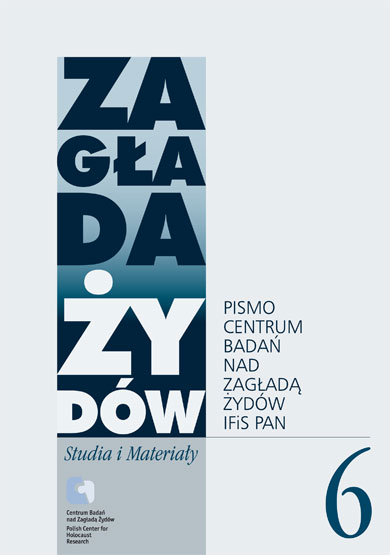Kicz i Holokaust, czyli pedagogiczny wymiar ekspozycji muzealnych
Zagłada Żydów. Studia i Materiały, Nr 6 (2010), Strony: 74-86
Data zgłoszenia: 2020-12-06Data publikacji: 2010-12-30
 https://doi.org/10.32927/zzsim.707
https://doi.org/10.32927/zzsim.707
Abstrakt
Museum exbibition is a medium consisting of multiple media but the whole is something more that the sum of its parts. Each exhibition is a kind of spectacle, a specific cultural creation, and it works according to its own rules. An exhibition is also the core of museum experience and, as such, it should be subject to multidimensional analysis. Meanwhile, the content of an exhibition and the material used in its construction are often assessed, and very little is said about it as a form of expression and the specific character of its influence on the public. In the article I analyze the exhibition in the United States Holocaust Memorial Museum in Washington in terms of the kitsch category. The term itself is hardly precise and it is multidimensional. Therefore I define it for the purposes of the and test to what extent it can be used to interpret goals and principles of assumptions behind historical exhibition dedicated to the Holocaust. The article is an exemplary interpretation of exhibition’s poetics and policy and it aims at demonstrating how pedagogical functions of museum exhibitions about the Holocaust may reduce its dimension to a lesson on intolerance.
Słowa kluczowe
Holokaust , reprezentacja , ekspozycja , kicz , pedagogika
Licencja
Prawa autorskie (c) 2010 Autor&"Zagłada Żydów. Studia i Materiały"

Utwór dostępny jest na licencji Creative Commons Uznanie autorstwa 4.0 Międzynarodowe.
https://creativecommons.org/licenses/by/4.0
Czasopismo publikowane jest w standardzie Diamond Open Access na licencji CC-BY-4.0 Deed - Uznanie autorstwa 4.0 Międzynarodowa - Creative Commons
Podobne artykuły
- Paweł Kosewski, Pamięć o Holokauście w kinie fabularnym (analiza retrospekcji filmowej, na podstawie filmów Pasażerka i The Pawnbroker) , Zagłada Żydów. Studia i Materiały: Nr 5 (2009)
- Jacek Leociak, Cenzor na straży Kościoła. Ocenzurowany pamiętnik Krystyny Modrzewskiej , Zagłada Żydów. Studia i Materiały: Nr 5 (2009)
- Dariusz Libionka, Polish Church Hierarchy and the Holocaust – an Essay from a Critical Perspective , Zagłada Żydów. Studia i Materiały: 2010: Holocaust Studies and Materials
- Paweł Dobrosielski, Opowiadanie Marka Hłaski „Szukając gwiazd” jako parabola Holokaustu i mityczne „wydarzenie początkowe” w twórczości pisarza , Zagłada Żydów. Studia i Materiały: Nr 4 (2008)
- Nawojka Cieślińska-Lobkowicz, Nowe Muzeum Holocaustu w Amsterdamie , Zagłada Żydów. Studia i Materiały: Nr 20 (2024)
- Barbara Krawcowicz, Teodycea w czasie Zagłady. Wojenne kazania rabina Szlomy Zalmana Unsdorfera , Zagłada Żydów. Studia i Materiały: Nr 15 (2019)
- Małgorzata Melchior, The Holocaust and Polish-Jewish Relations in Sociological Studies , Zagłada Żydów. Studia i Materiały: 2008: Holocaust Studies and Materials
- Andrzej Żbikowski, Texts Buried in Oblivion. Testimonies of Two Refugees from the Mass Grave at Poniatowa , Zagłada Żydów. Studia i Materiały: 2008: Holocaust Studies and Materials
- Natalia Aleksiun, Polska i zagraniczna historiografia na temat stosunków polsko-żydowskich w okresie drugiej wojny światowej , Zagłada Żydów. Studia i Materiały: Nr 1 (2005)
- Jurij Radczenko, „Niemcy znaleźli u nich zrabowane żydowskie rzeczy i dlatego ich rozstrzelali”: Kureń Bukowiński, Holokaust w Kijowie i świadectwo Marty Zybaczynskiej , Zagłada Żydów. Studia i Materiały: Nr 14 (2018)
Możesz również Rozpocznij zaawansowane wyszukiwanie podobieństw dla tego artykułu.
 English
English
 Język Polski
Język Polski




